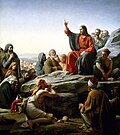
Back ديداخي Arabic Didaché AST Дидахе Bulgarian La Didakhé Catalan Didaché Czech Didaké Danish Didache German Διδαχή των Δώδεκα Αποστόλων Greek Didakeo Esperanto Didaché Spanish

The Didache (/ˈdɪdəkeɪ, -ki/; Greek: Διδαχή, translit. Didakhé, lit. "Teaching"),[1] also known as The Lord's Teaching Through the Twelve Apostles to the Nations (Διδαχὴ Κυρίου διὰ τῶν δώδεκα ἀποστόλων τοῖς ἔθνεσιν), is a brief anonymous early Christian treatise (ancient church order) written in Koine Greek, dated by modern scholars to the first[2] or (less commonly) second century AD.[3]
The first line of this treatise is: "The teaching of the Lord to the Gentiles (or Nations) by the twelve apostles".[a] The text, parts of which constitute the oldest extant written catechism, has three main sections dealing with Christian ethics, rituals such as baptism and Eucharist, and Church organization. The opening chapters describe the virtuous Way of Life and the wicked Way of Death. The Lord's Prayer is included in full. Baptism is by immersion, or by affusion if immersion is not practical. Fasting is ordered for Wednesdays and Fridays. Two primitive Eucharistic prayers are given. Church organization was at an early stage of development. Itinerant apostles and prophets are important, serving as "chief priests" and possibly celebrating the Eucharist; meanwhile, local bishops and deacons also have authority and seem to be taking the place of the itinerant ministry.[2]
The Didache is considered the first example of the genre of Church Orders.[2] It reveals how Jewish Christians saw themselves and how they adapted their practice for Gentile Christians.[4] It is similar in several ways to the Gospel of Matthew, perhaps because both texts originated in similar communities.[5] The opening chapters, which also appear in other early Christian texts like the Epistle of Barnabas, are likely derived from an earlier Jewish source.[2]
The Didache is considered part of the group of second-generation Christian writings known as the Apostolic Fathers. The work was considered by some Church Fathers to be a part of the New Testament,[b] while being rejected by others as spurious or non-canonical.[6][7] In the end, it was not accepted into the New Testament canon. However, works which draw directly or indirectly from the Didache include the Didascalia Apostolorum, the Apostolic Constitutions and the Ethiopic Didascalia, the latter of which is included in the broader canon of the Ethiopian Orthodox Church.

Lost for centuries, a Greek manuscript of the Didache was rediscovered in 1873 by Philotheos Bryennios, Metropolitan of Nicomedia, in the Codex Hierosolymitanus. A Latin version of the first five chapters was discovered in 1900 by J. Schlecht.[8]
| Part of a series on |
| Jewish Christianity |
|---|
 |
- ^ Liddell, Henry George; Scott, Robert (1940). "διδαχή". A Greek–English Lexicon. Revised and augmented throughout by Sir Henry Stuart Jones, with the assistance of Roderick McKenzie. Oxford: Clarendon Press.
- ^ a b c d Cross & Livingstone 2005, p. 482.
- ^ Britannica, The Editors of Encyclopaedia. "Didachē". Encyclopedia Britannica, 18 Oct. 2021, https://www.britannica.com/topic/Didache. Accessed 28 December 2023.
- ^ Milavec 2003b, p. vii.
- ^ Cite error: The named reference
Matthew and the Didachewas invoked but never defined (see the help page). - ^ Athanasius Festal Letter 39 (excludes them from the canon, but recommends them for reading) in 367
- ^ Nicephorus in Stichometria
- ^ John Chapman (1913). . In Herbermann, Charles (ed.). Catholic Encyclopedia. New York: Robert Appleton Company.
Cite error: There are <ref group=lower-alpha> tags or {{efn}} templates on this page, but the references will not show without a {{reflist|group=lower-alpha}} template or {{notelist}} template (see the help page).